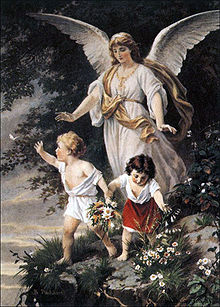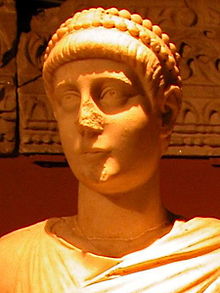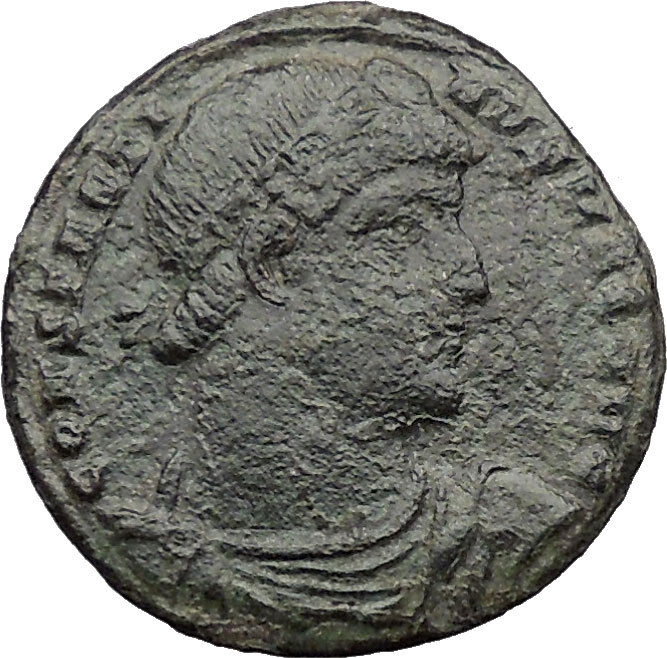|
Valentinian II – Roman Emperor: 375-392 A.D.
Bronze AE4 14mm (1.39 grams) Aquileia mint, struck 388-392 A.D.
Reference: RIC 58a; LRBC 1105
D N VALENTINIANVS P F AVG, Pearl-diademed, draped, cuirassed bust right.
SALVS REIPVBLICAE / (staurogram)/AQP, Victory advancing left, holding trophy and dragging captive.
You are bidding on the exact item pictured, provided with a Certificate of Authenticity and Lifetime Guarantee of Authenticity.
Staurogram _I_193_2.jpg/20px-Christliche_Symbolik_(Menzel)_I_193_2.jpg)
The Staurogram (meaning monogram of the cross, from the Greek σταυρός, i.e. cross), or Monogrammatic Cross or Tau-Rho symbol, is composed by a tau (Τ) superimposed on a rho (Ρ). The Staurogram was first used to abbreviate the Greek word for cross in very early New Testament manuscripts such as P66, P45 and P75, almost like a nomen sacrum, and may visually have represented Jesus on the cross.
Ephrem the Syrian in the 4th-century explained these two united letters stating that the tau refers to the cross, and the rho refers to the Greek word “help” which has the numerological value in Greek of 100 as the letter rho has. In such a way the symbol expresses the idea that the Cross saves. The two letters tau and rho can also be found separately as symbols on early Christian ossuaries.
The tau was considered a symbol of salvation due to the identification of the tau with the sign which in Ezekiel 9:4 was marked on the forehead of the saved ones, or due to the tau-shaped outstretched hands of Moses in Exodus 17:11. The rho by itself can refer to Christ as Messiah because Abraham, taken as symbol of the Messiah, generated Isaac according to a promise made by God when he was one hundred years old, and 100 is the value of rho.:158
The Monogrammatic Cross was later seen also as a variation of the Chi Rho symbol, and it spread over Western Europe in the 5th and 6th centuries.
 In ancient Roman religion, Victoria or Victory was the personified goddess of victory. She is the Roman equivalent of the Greek goddess Nike, and was associated with Bellona. She was adapted from the Sabine agricultural goddess Vacuna and had a temple on the Palatine Hill. The goddess Vica Pota was also sometimes identified with Victoria. In ancient Roman religion, Victoria or Victory was the personified goddess of victory. She is the Roman equivalent of the Greek goddess Nike, and was associated with Bellona. She was adapted from the Sabine agricultural goddess Vacuna and had a temple on the Palatine Hill. The goddess Vica Pota was also sometimes identified with Victoria.
Unlike the Greek Nike, the goddess Victoria (Latin for “victory”) was a major part of Roman society. Multiple temples were erected in her honor. When her statue was removed in 382 CE by Emperor Gratianus there was much anger in Rome. She was normally worshiped by triumphant generals returning from war.
Also unlike the Greek Nike, who was known for success in athletic games such as chariot races, Victoria was a symbol of victory over death and determined who would be successful during war.
Victoria appears widely on Roman coins, jewelry, architecture, and other arts. She is often seen with or in a chariot, as in the late 18th-century sculpture representing Victory in a quadriga on the Brandenburg Gate in Berlin, Germany; “Il Vittoriano” in Rome has two.
Winged figures, very often in pairs, representing victory and referred to as “victories”, were common in Roman official iconography, typically hovering high in a composition, and often filling spaces in spandrels or other gaps in architecture. These represent the spirit of victory rather than the goddess herself. They continued to appear after Christianization of the Empire, and slowly mutated into Christian angels.
 The symbolism of angels has been adopted from the ancient Roman goddess of victory by the early Christians. The goddess transformed into what is known by the Christians as angels via the Christianization of the Roman empire. This is evidenced by many coins still depicting victory, yet of the time period where Christianity was already the official religion of the Roman empire. She appears along with symbols such as a Christogram (also known as a Chi-Rho which is a monogram of Jesus Christ), Staurogram, and the cross, attributing to it’s Christian symbolism. The symbolism of angels has been adopted from the ancient Roman goddess of victory by the early Christians. The goddess transformed into what is known by the Christians as angels via the Christianization of the Roman empire. This is evidenced by many coins still depicting victory, yet of the time period where Christianity was already the official religion of the Roman empire. She appears along with symbols such as a Christogram (also known as a Chi-Rho which is a monogram of Jesus Christ), Staurogram, and the cross, attributing to it’s Christian symbolism.
An angel is a purely spiritual being found in various religions and mythologies. In Abrahamic religions and Zoroastrianism, angels are often depicted as benevolent celestial beings who act as intermediaries between God or Heaven and Earth, or as guardian spirits or a guiding influence. Other roles of angels include protecting and guiding human beings, and carrying out God’s tasks. The term “angel” has also been diversified to various notions of spirits or figures found in many other religious traditions. The theological study of angels is known as “angelology”. In art, angels are often depicted with bird-like wings on their back, a halo, robes and various forms of glowing light.
 Valentinian II – 375-392 A.D. Valentinian II – 375-392 A.D.
375-383 A.D. Junior Augustus (with Gratian)
383-392 A.D. Sole reign
Ruling in the East: Valens (364-378 A.D.), Theodosius I (379-395 A.D.) and Arcadius (383-408 A.D.)
| Son of Valentinian I (and Justina) | Brother of Galla (wife of Theodosius I) | Half-brother of Gratian | Nephew of Valens | Brother-in-law of Theodosius I |
Flavius Valentinianus (371 – 15 May 392), known usually by his anglicised name, Valentinian II, was a Roman Emperor from 375 to 392.
Early Life and Accession (371-375)
Flavius Valentinianus was born to Emperor Valentinian I and his second wife, Justina. He was the half-brother of Valentinian’s other son, Gratian, who had shared the imperial title with his father since 367. He had three sisters Galla, Grata and Justa. The elder Valentinian died on campaign in Pannonia in 375. Neither Gratian (then in Trier) nor his uncle Valens (emperor for the East) were consulted by the army commanders on the scene. Instead of merely acknowledging Gratian as his father’s successor, Valentinian I’s generals acclaimed the four-year old boy augustus on 22 November 375. The army may have been uneasy about Gratian’s lack of military ability, and so raised a boy who would not immediately aspire to military command.
Reign from Milan (375-387)
Gratian, forced to accommodate the generals who supported his half-brother, governed the trans-alpine provinces (including Gaul, Hispania, and Britain), while Italy, part of Illyricum, and Africa were under the rule of Valentinian. In 378, their uncle, the Emperor Valens, was killed in battle with the Goths at Adrianople, and Gratian invited the general Theodosius to be emperor in the East. As a child, Valentinian II was under the influence of his Arian mother, the Empress Justina, and the imperial court at Milan, an influence contested by the Catholic bishop of Milan, Ambrose.
Justina used her influence over her young son to oppose the Catholic party which was championed by Ambrose. In 385 Ambrose, backed by Milan’s populace, refused an imperial request to hand over the Portian basilica for the use of Arian troops. In 386 Justina and Valentinian received the Arian bishop Auxentius, and Ambrose was again ordered to hand over a church in Milan for Arian usage. Ambrose and his congregation barricaded themselves inside the church, and the imperial order was rescinded. Magnus Maximus used the emperor’s heterodoxy against him, and even his eventual protector, Theodosius, cast aspersions on his Arianism. Valentinian also tried to restrain the despoiling of pagan temples in Rome. Buoyed by this instruction, the pagan senators, led by Aurelius Symmachus, the Prefect of Rome, petitioned in 384 for the restoration of the Altar of Victory in the Senate House, which had been removed by Gratian in 382. Valentinian, at the insistence of Ambrose, refused the request and, in so doing, rejected the traditions and rituals of pagan Rome to which Symmachus had appealed.
In 383, Magnus Maximus, commander of the armies in Britain, declared himself Emperor and established himself in Gaul and Hispania. Gratian died while fleeing him. For a time the court of Valentinian, through the mediation of Ambrose, came to an accommodation with the usurper, and Theodosius recognized Maximus as co-emperor of the West. However, in 386 or 387, Maximus crossed the Alps into the Po valley and threatened Milan. Valentinian II and Justina fled to Theodosius in Thessalonica. The latter came to an agreement, cemented by his marriage to Valentinian’s sister Galla, to restore the young emperor in the West. In 388, Theodosius marched west and defeated Maximus. Although he was to appoint both of his sons emperor (Arcadius in 383, Honorius in 393), Theodosius remained loyal to the dynasty of Valentinian I.
After the defeat of Maximus, Theodosius remained in Milan until 391. Valentinian took no part in Theodosius’ triumphal celebrations over Maximus. Valentinian and his court were installed at Vienne in Gaul, while Theodoisus appointed key administrators in the West, and had coins minted which implied his guardianship over the 17 year old. Justina had already died, and Vienne was far away from the influence of Ambrose. Theodosius’ trusted general, the Frank Arbogast, was appointed magister militum for the Western provinces (bar Africa) and guardian of Valentinian. Acting in the name of Valentinian, Arbogast was actually subordinate only to Theodosius. While the general campaigned successfully on the Rhine, the young emperor remained at Vienne, in contrast to his warrior father and his older brother, who had campaigned at his age. Arbogast’s domination over the emperor was considerable, and the general even murdered Harmonius, a friend of Valentinian suspected of taking bribes, in the emperor’s presence.
The crisis reached a peak when Arbogast prohibited the emperor from leading the Gallic armies into Italy to oppose a barbarian threat. Valentinian, in response, formally dismissed Arbogast. The latter ignored the order, publically tearing it up and arguing that Valentinian had not appointed him in the first place. The reality of where the power lay was openly displayed. Valentinian wrote to Theodosius and Ambrose complaining of his subordination to his general. In explicit rejection of his earlier Arianism, he invited Ambrose to come to Vienne to baptize him.
However, on 15 May 392, Valentinian was found hanged in his residence in Vienne. Arbogast maintained that the emperor’s death was suicide. While our main source, Zosimus writing in the early sixth century from Constantinople, states that the Frank had Valentinian murdered, ancient authorities are divided in their opinion. The young man’s body was conveyed in ceremony to Milan for burial by Ambrose, mourned by his sisters Justa and Grata. The bishop’s eulogy is the only contemporary Western source for Valentinian’s death. It is ambiguous on the question of the emperor’s death, which is not surprising, as Ambrose represents him as a model of Christian virtue. Suicide, not murder, would make Ambrose dissemble on this key question.
At first Arbogast recognized Theodosius’s son Arcadius as emperor in the West, seemingly surprised by his charge’s death. After three months, during which he had no communication from Theodosius, Arbogast selected an imperial official, Eugenius, as emperor. Theodosius initially tolerated this regime but, in January 393, elevated the eight year old Honorius as augustus to succeed Valentinian II. Civil war ensued and, in 394, Theodosius defeated Eugenius and Arbogast.
Significance
Valentinian himself seems to have exercised no real authority, and was a figurehead for various powerful interests: his mother, his co-emperors, and powerful generals. Since the Crisis of the Third CenturyDiocletian and his collegiate system. While Constantine and his sons had been strong military figures, they had also re-established the practice of hereditary succession, adopted by Valentinian I. The obvious flaw in these two competing requirements came in the reign of Valentinian II, a child. His reign was a harbinger of the fifth century, when children or nonentities, reigning as emperors, were controlled by powerful generals and officials.
|





_I_193_2.jpg/20px-Christliche_Symbolik_(Menzel)_I_193_2.jpg)
 In ancient Roman religion, Victoria or Victory was the personified goddess of victory. She is the Roman equivalent of the Greek goddess Nike, and was associated with Bellona. She was adapted from the Sabine agricultural goddess Vacuna and had a temple on the Palatine Hill. The goddess Vica Pota was also sometimes identified with Victoria.
In ancient Roman religion, Victoria or Victory was the personified goddess of victory. She is the Roman equivalent of the Greek goddess Nike, and was associated with Bellona. She was adapted from the Sabine agricultural goddess Vacuna and had a temple on the Palatine Hill. The goddess Vica Pota was also sometimes identified with Victoria. The symbolism of angels has been adopted from the ancient Roman goddess of victory by the early Christians. The goddess transformed into what is known by the Christians as angels via the Christianization of the Roman empire. This is evidenced by many coins still depicting victory, yet of the time period where Christianity was already the official religion of the Roman empire. She appears along with symbols such as a Christogram (also known as a Chi-Rho which is a monogram of Jesus Christ), Staurogram, and the cross, attributing to it’s Christian symbolism.
The symbolism of angels has been adopted from the ancient Roman goddess of victory by the early Christians. The goddess transformed into what is known by the Christians as angels via the Christianization of the Roman empire. This is evidenced by many coins still depicting victory, yet of the time period where Christianity was already the official religion of the Roman empire. She appears along with symbols such as a Christogram (also known as a Chi-Rho which is a monogram of Jesus Christ), Staurogram, and the cross, attributing to it’s Christian symbolism. 





